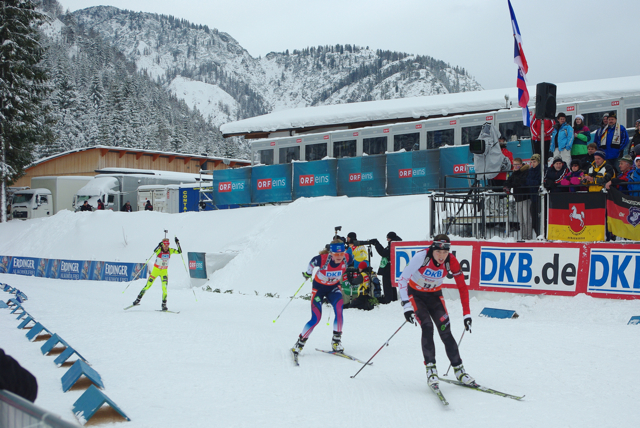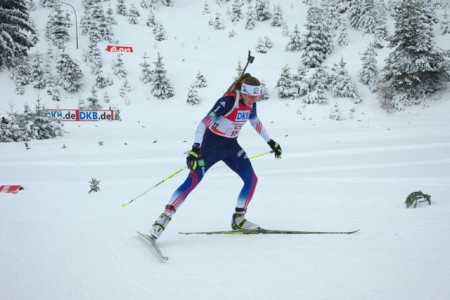
HOCHFILZEN, Austria – Lanny Barnes has done a lot of relays before. But the 31-year-old had never quite found herself in the position she had today: going into the anchor leg of the 4 x 6 k World Cup relay, the United States was in seventh place, less than a minute and a half behind the leading team from Ukraine and only 40 seconds from the podium.
“The other three girls they did an awesome job of putting me right up in there,” she said. Barnes proceeded to hit all of her targets and the U.S. finished eighth, by far the best result of any of the racers’ careers. The previous best was tenth place in Antholz, Italy, last season.
Coming in with bib 17, a 16th-place ranking in the Nations Cup, and tough results the day before when none of the women made the top 60 in the sprint, the United States definitely wasn’t expected to make the top eight. It seemed like it would be especially tough with Annelies Cook, the team’s number two athlete, sitting out. Luckily the Americans are traveling with five women, so both Barnes and Hannah Dreissigacker, who had been expecting to fight each other for a chance in the relay, got to start.
To have the depth to finish eighth without one of the relay team’s traditional members? That’s certainly something new.
“It says a lot about the women’s program,” Barnes said. “We’re on our way up and even though we had a really disappointing day yesterday, it was good to come back and have a decent result today.”
For various reasons, the team really needed a strong result to get their mojo back. The most obvious was the sprint yesterday, which was mainly hampered by poor shooting: except for Barnes, the other three starters (Susan Dunklee, Cook, and Dreissigacker) all had four penalties.
Not so today, when the team used just three spare rounds between all of them over the course of eight shooting stages.
“It’s a really great statement what they are doing today,” shooting coach Armin Auchentaller said midway through the third leg. “They are awesome today – they have no penalties in prone and they’re in a good spot. They are fighting hard on the track out there and it’s really nice to see them perform in this way. It’s for sure for all of them a great confidence-booster and this will bring them forward.”

But there were other things, too. Dreissigacker, Barnes, and Sara Studebaker are competing for two starting positions in individual races (Cook and Dunklee have the first two of the Americans’ four-woman quota). Studebaker had to sit out the sprint, which was something of a blow. Dreissigacker has been on the bubble for basically her whole international career and is constantly trying to get results good enough to hang onto her starting spot. And Barnes is attempting a comeback after compartment syndrome surgery.
So for these women in particular, it was mission accomplished. The team member who has been on the circuit the longest, Barnes was helped out by a bit of history when she found herself setting out on course in seventh place. She showed why she was a staple of U.S. teams for so long as she was calm, collected, and perfect on the range – as well as the fastest shooter in both of her bouts – despite intense pressure.
“It was especially great to have the opportunity to do the relay here – I think I’ve cleaned every relay I have ever done here, so it gave me a little confidence in the shooting,” Barnes said. “Especially when it’s head to head and there’s a lot of pressure, because when I was coming into the range on the last loop, I could still hear the top girls just leaving. So I was really excited to have that pressure, to know that I have to hit them or else we’re dropping back, way back.”
Skiing the third leg, Dreissigacker bounced back hard from her disappointment the day before. She cleaned prone, used a single spare in standing, and skied the eighth-fastest time of all the third-leg racers.
“It’s such a relief that I can actually hit my prone targets,” she said. “This is what I have been wanting to do – to mix it up with other fast girls. And this was such a good opportunity to do that. It was just fun. That’s what biathlon is about, when it’s really a race and you’re moving back and forth. I hadn’t really gotten that chance yet [this season], so it was awesome.”
And Studebaker came out of the gate with a vengeance after missing out on Friday’s action. She didn’t need any spare rounds to clean her targets.
“Personally, it was a little bit of both,” she said when asked whether the extra rest day was a benefit or a detriment. “I was bummed not to race yesterday and I need races to get into feeling better, but at the same time it made me more hungry today to go out there and really get it… It was definitely the race that I was hoping to have after sitting out yesterday. Clean shooting, and I got to ski around some fast people.”
By the time Studebaker was finished and Dreissigacker took over, the team was in 13th. That sounds about like their usual relay results – unspectacular. But in fact, it was the perfect setup for a run towards the top.
“It was a really good place,” Dreissigacker said. “13th doesn’t sound that great but we were right with a lot of people. They really weren’t far ahead. It was the perfect opportunity to think that there’s not a lot of pressure, but they are right there and I can ski with them and shoot better than them.”
For someone like Dreissigacker, who has relatively little World Cup experience and has to treat each race like a trial to keep her spot, the relay was something of a comfort, rather than being an added stress.
“Honestly, I think I race a lot better when I’m not super, super nervous and really putting a lot of pressure on myself,” she said. “I definitely really want to do my best for the team, but having other people being a part of it too takes some pressure off and it really allowed me to just relax and say, okay, this is my focus. And then do that, just ski with that girl who is right there.”
Dreissigacker said that last night in their prep work the women “didn’t dwell on” their disappointing results in the sprint. Instead, they treated the relay like a new opportunity.
“First of all we always want to finish higher than our bib,” Studebaker said. “But it was the first relay and we’re trying some different stuff. Susan was scrambling [for the first time], and Annelies isn’t feeling great so she’s sitting out, so we were just hoping to get that relay feel and come together as a team and have a good result. We haven’t had the best team results usually, so we thought we’d try to turn it around here.”
Seems like it worked
“It was really awesome to start out the first relay like that,” Barnes concluded. “It was fun.”
Chelsea Little
Chelsea Little is FasterSkier's Editor-At-Large. A former racer at Ford Sayre, Dartmouth College and the Craftsbury Green Racing Project, she is a PhD candidate in aquatic ecology in the @Altermatt_lab at Eawag, the Swiss Federal Institute of Aquatic Science and Technology in Zurich, Switzerland. You can follow her on twitter @ChelskiLittle.



